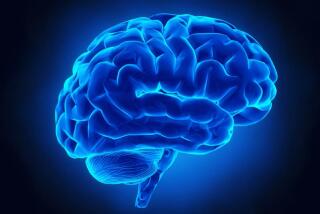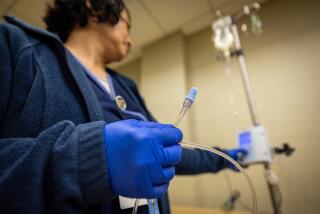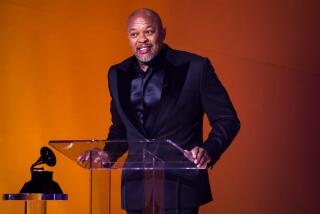COLUMN ONE : Caring for the Brain Under Siege : Where once tragedy seemed all but certain, doctors are using new drugs and treatments to fight strokes. They hope to one day transplant human nerve cells back into brains to repair damage.
- Share via
NEW YORK — Sometimes, the symptoms start subtly. Unlike the crushing pain of a heart attack, the assault begins as mere numbness. Faced with weakness on one side of the body, the temptation often is to turn over, go back to sleep and hope things will be better in the morning.
Physicians say that is the worst thing to do. To ignore the symptoms of a stroke is to disregard peril. Every year, 500,000 Americans suffer strokes and 150,000 die. Strokes are the nation’s third leading cause of death, surpassed only by heart disease and cancer. For some survivors, the consequences can be devastating: disability, lost productivity and high medical costs.
Many people view strokes as an inevitable consequence of aging, carrying the grim prognosis that little can be done.
Now, doctors say, that is starting to change.
Neurology still has its limits, but more and more the specialty is shifting from an almost exclusive focus on diagnosis to embrace new treatments--especially if action is taken early.
For strokes--and a range of other neurological illnesses--doctors are experimenting with promising drugs and treatment techniques. Advances in imaging routinely provide remarkable pictures of the brain, allowing physicians to quickly pinpoint problems--and begin the search for solutions.
In neurology wards, triumphs are occurring in cases where once only tragedy reigned.
*
Caring for the brain under siege is a difficult task. Physicians often walk a tightrope between success and failure.
Nowhere is that more evident than on Payson Six, the neurology floor of the New York Hospital-Cornell Medical Center. It began in 1949 as rows of iron lungs during a terrible polio epidemic before the Salk vaccine was invented. It has evolved into one of the nation’s leading treatment, teaching and research centers in large measure because of Dr. Fred Plum, the neurologist-in-chief.
The public caught glimpses of the gray-haired physician last spring, when he served as Richard Nixon’s neurologist after the massive stroke that led to the former President’s death.
Over more than four decades, Plum has seen perhaps 60,000 cases--”a small city,” he says dryly. If anything, the exposure to so many people only has increased his awe of the brain.
“We are our minds,” he says simply. “The brain is the self.”
At 70, Plum remains a precise, hard-driving, no-nonsense taskmaster--a superb bedside teacher.
Twice a week, he holds teaching rounds on Payson Six. One day, followed by young physicians and medical students, Plum strode to the bedside of a woman whose dark hair had been partially shaved, showing fresh stitches. Confronted by all the doctors in white coats, she blurted out her own diagnosis:
“I have an aneurysm,” she announced, briefly stifling discussion of her case.
She was a flight attendant who suddenly had suffered the worst headache of her life while worshiping a few days earlier in St. Patrick’s Cathedral. She told a young priest to call the paramedics. But above all, she didn’t want to disturb Cardinal John O’Connor, who was conducting services.
Neurosurgeons clipped off the bleeding blood vessel, but brain scans revealed she had a second aneurysm--a sac formed by an enlargement of a weakened artery wall. It was probably the result of a genetic defect in the brain’s blood vessel architecture. Surgeons planned to operate to prevent it from rupturing.
“You have one more to treat,” Plum reassured her. “Everything about you makes us think you will do well.”
“I thought I was finished,” the woman said.
In the bed directly across the room, a man in his 20s lay unconscious. He had been that way for a month after falling 20 feet off an escalator. Plum focused the bright beam of his penlight into the patient’s right eye. His pupil barely reacted. Above the bed, the green spikes of a cardiac monitor showed his heartbeat.
The man’s right hand made small, scratching movements--spasms that Plum explained were typical of overwhelmingly bad brain injuries.
“George, Henry, Mike,” he said in a loud voice. There was no response. He moved the man’s hand.
“What I am seeing is not reflex activity,” Plum told the group.
A medical student stared at the patient, who was not much older than herself.
“God,” she said softly.
“The family has to be told we have no evidence he understands language or has sustained attention,” Plum continued. “ . . . We are very concerned about his outcome. In all likelihood, their son will never recover the thing that drives us, the business of enthusiasm and taking rewards from what the day brings.”
When all the doctors emerged into the hallway, a friend of the patient asked how he was doing.
“He’s unchanged,” one of the residents said.
*
Most strokes occur as a complication of illnesses such as heart disease, high blood pressure and hardening of the arteries. Patients may suddenly be unable to speak or move an arm or leg, to see or feel. The damage can be transient or permanent.
Not all strokes are alike. One kind takes place when a vessel inside the brain ruptures, flooding tissues with blood. About 80% occur when a blood clot formed elsewhere in the body blocks a brain artery. Brain cells deprived of oxygen can quickly die. Further injury from a cascade of biological reactions lasting for hours, even days, can spread the initial damage.
Once a stroke occurs, doctors now know, time becomes the enemy. They must be alert to a wide range of problems: potential threats to the lungs, the immune system, the joints.
Stroke patients are prone to brain swelling because, encased in the skull, tissues have no room to expand. Without medical action, death can result.
Nurses in Payson Six’s four-bed intensive-care unit constantly search for signs that swelling has begun. An early clue: Patients may suddenly become fidgety and fussy.
About 20 years ago, the Veterans Administration conducted a landmark trial examining the effects of hypertension on heart disease. It yielded an unexpected but important finding. When high blood pressure was reduced, deaths from strokes dropped dramatically. High blood pressure contributes significantly to 90% of strokes.
Other studies have shown that by giving anti-coagulants to patients with irregular heartbeats, the risk of stroke decreases by lessening the chance that blood clots, which can travel to the brain, will be formed in the heart.
Recent advances in cardiac imaging have refined clotting topography. Researchers have discovered that many clots thought to travel to the brain from the heart actually come from the aorta, the main artery of the body carrying blood from the left ventricle of the heart.
With that knowledge, a few surgeons around the country already are cleaning out the aorta, much in the way that partially blocked carotid arteries are cleared of fatty deposits--a more common procedure.
In September, the National Institute of Neurological Disorders and Stroke strongly endorsed the carotid surgery, noting the procedure reduced the five-year risk of stroke by about half in patients whose arteries were significantly narrowed by as much as 60%.
New drugs and medical procedures also are improving the likelihood of survival without serious complications--providing treatment begins rapidly inasmuch as brain cells can quickly die.
One of the most promising approaches involves the use of so called “clotbusters,” such as tissue plasminogen activator (tPA). These have proved effective in limiting damage from heart attacks.
Major clinical trials of tPA around the country have produced promising results.
“We have lots of patients in the trials who have made miraculous recoveries,” says Dr. Patrick Lyden of UC San Diego. Doctors have not yet sorted out which of the patients had received placebos, he adds, “but we are very hopeful.”
Lyden heads a team of stroke specialists who are on alert to treat victims brought to five San Diego hospitals.
Researchers also are studying a variety of drugs designed to reduce the damage once a stroke occurs.
In a stricken patient’s brain, an excess amount of glutamate, an amino acid, is excreted. This excess flow can kill healthy cells around the original site of the stroke. One drug being tested at New York Hospital and other institutions is designed to block the flow of glutamate.
On Payson Six, Dr. Steven A. Goldman and colleague Dr. Denise Barbut (who is studying strokes related to open-heart surgery) treated a man in his 60s who suffered a serious stroke while undergoing cardiac catheterization.
The patient, partially blind and paralyzed on the left side, was rushed to the neurology floor, and within an hour took part in the clinical trial of a new medication that blocks the glutamate flow. After three days, the patient was cured.
“We have had three or four enormous surprises,” Barbut says, couching her excitement in the careful language of science. “I don’t know to this day how many of those (in our study) actually had the drug and how many received a placebo. But we have never had the surprise without the drug, put it that way. The number of surprises is increasing with these studies.”
To glimpse the future of neurology, it is only necessary to walk a short distance from Payson Six to Goldman’s laboratory.
The researcher, who is both a neurologist and holds a Ph.D in neurobiology, places a petri dish with tiny dots of tissue--human brain cells growing--under a microscope. To see their slender filaments branching out to other nerve cells more than inspires reflection. In its most primitive form, it is the architecture of communication.
In each second, the brain can take in perhaps 100 million pieces of information; we concentrate on about 40 of them and shut out the rest. Researchers estimate the brain contains up to 2 billion nerve cells. On each cell’s surface are perhaps 60,000 contact points--receptors. Multiply cells by receptors and the organ’s complexity becomes clear.
Goldman’s research began a decade ago on the brains of canaries. Later, he was able to grow nerve cells from rats and from human brain tissue.
Goldman and his postdoctoral fellow Barry Kirschenbaum are about to publish evidence in the journal “Cerebral Cortex” that these neurons are generated from early precursor cells in the adult human brain.
The ultimate goal is to transplant human nerve cells back into brains to repair damage. But first, a host of questions remain--including whether the brain will accept cells grown in a laboratory and whether they will assume the functions of their neighbors.
One of the first lessons physicians and nurses quickly learn on Payson Six is to appreciate their own mortality.
“When you close your eyes, it could be you,” says Rita Kraut, head nurse on the floor. “It makes you realize there is nothing insignificant in this world. Everything is important. We have a tendency to put things off and do it tomorrow. But you see a lot of times there is no tomorrow.”
Bad news seems to come in nooks and crannies. A physician or a nurse will take someone to one of the small alcoves on Payson Six to discuss sending a loved one to a hospice or home to die. Physicians treat about 1,000 patients a year on the floor; about 25% die or remain very seriously disabled.
“The biggest strain is identifying those people we can give quality of life back to, and communicate to the family there is hope, versus that there is not anything we can do,” says Dr. David Hewitt, the chief resident on Payson Six.
He hurries into a room with brightly lit screens for a radiology conference. MRI scans are starkly illuminated as he presents histories while a neuro-radiologist interprets them.
Hewitt says a woman with a paralyzed right arm has gone into a coma. The radiologist looks at her brain scans. They indicate a massive stroke.
Physicians had ordered scans for an elderly women with a history of cancer to rule out any spread. The radiologist studies her scans, peering at a very small darker shadow before speaking in chilling, antiseptic shorthand.
“It might be a little met,” he said, referring to the tumor metastasizing.
Inherent in the process is a wrenching paradox. Advances in imaging often have made diagnosis exquisitely precise. But the technology also has given physicians earlier knowledge of what, in all likelihood, will be fatal.
Even in the face of bad news, a rule exists in neurology: Beware the nihilist. Every doctor and nurse on Payson Six has experienced surprises. Kraut remembers the 17-year-old girl who was in a coma for three months with encephalitis. One day, she woke up and called the head nurse by name.
“I was floored! She came back every Christmas to bring us cookies with her parents because she got a new lease on life,” Kraut says.
Alice Letherbarrow, a critical care nurse, recalls the man who had a stroke followed by almost every complication in the book. He was on a respirator. He had pneumonia. It was touch and go.
The complications gradually were overcome through antibiotics and other measures.
The memory of what happened next is still special.
“About two months later, he came back and he walked into the unit and said, ‘Hi, Allie. I came to see you.’ That made me feel like, wow, this is just incredible,” Letherbarrow says. “It’s like a big yahoo! It makes you feel really big to say, ‘Wow, I made a difference in this man’s life.’ ”
Times medical writer Thomas H. Maugh II contributed to this story.






